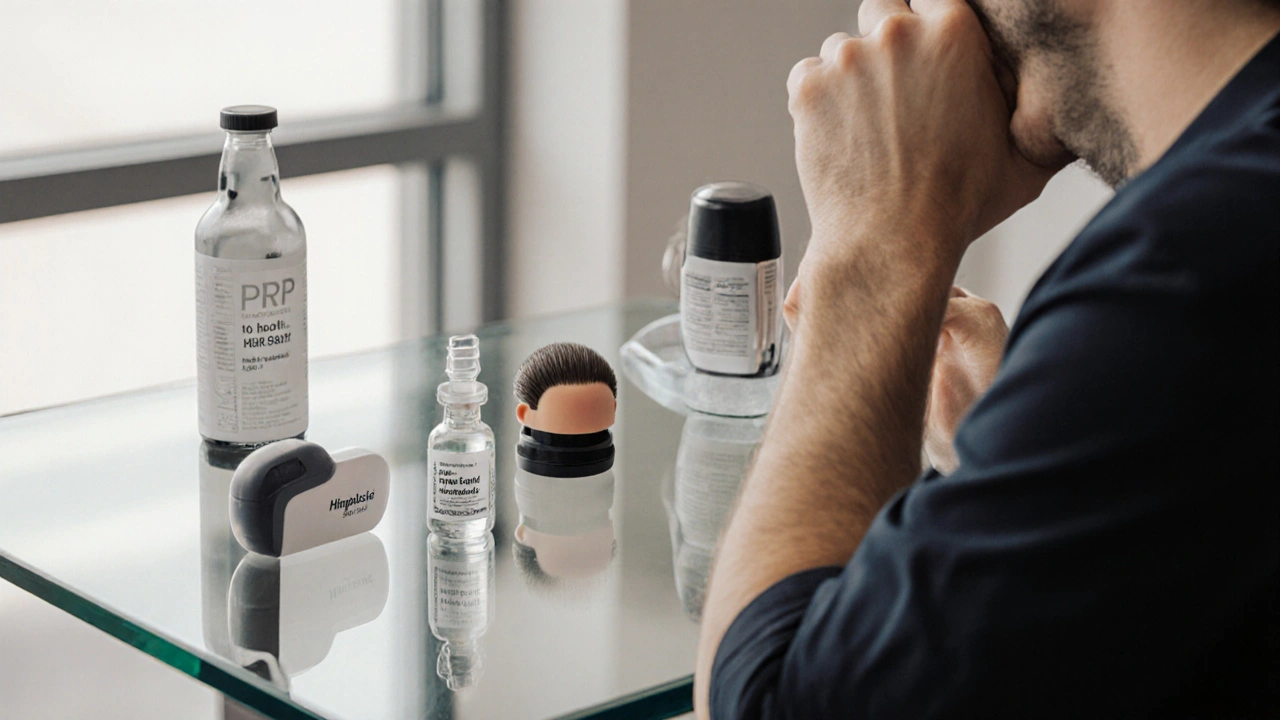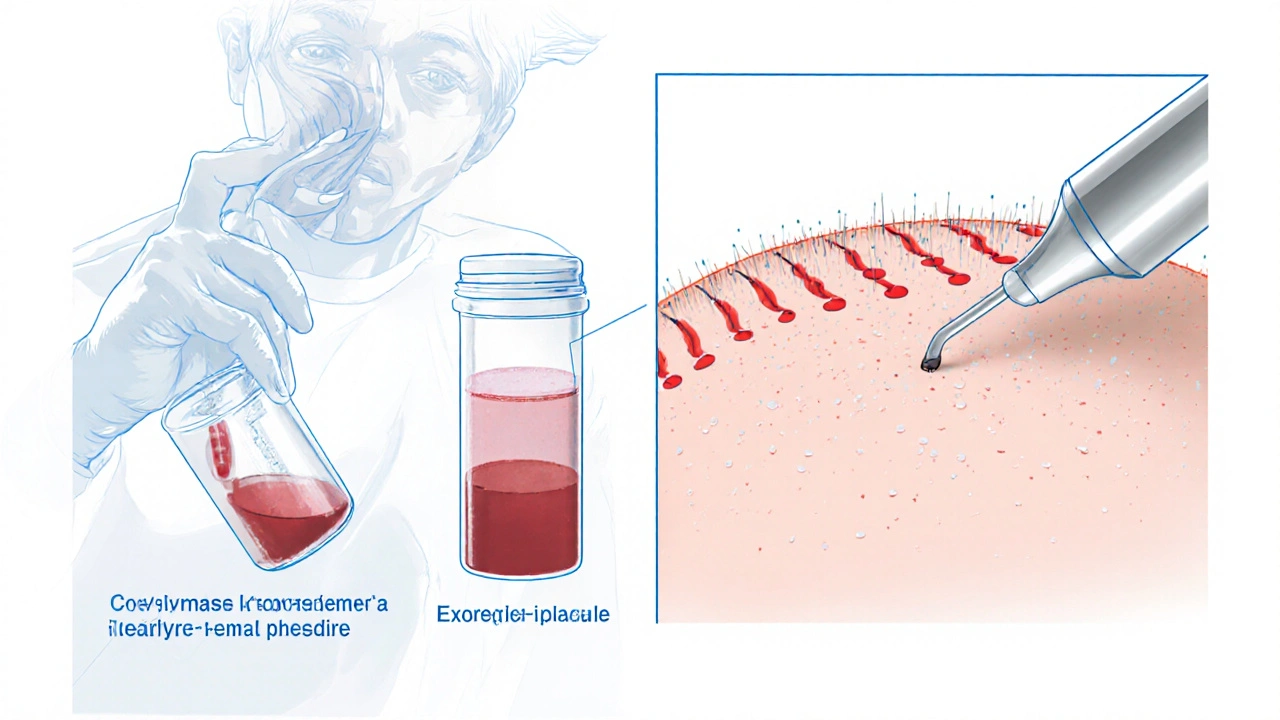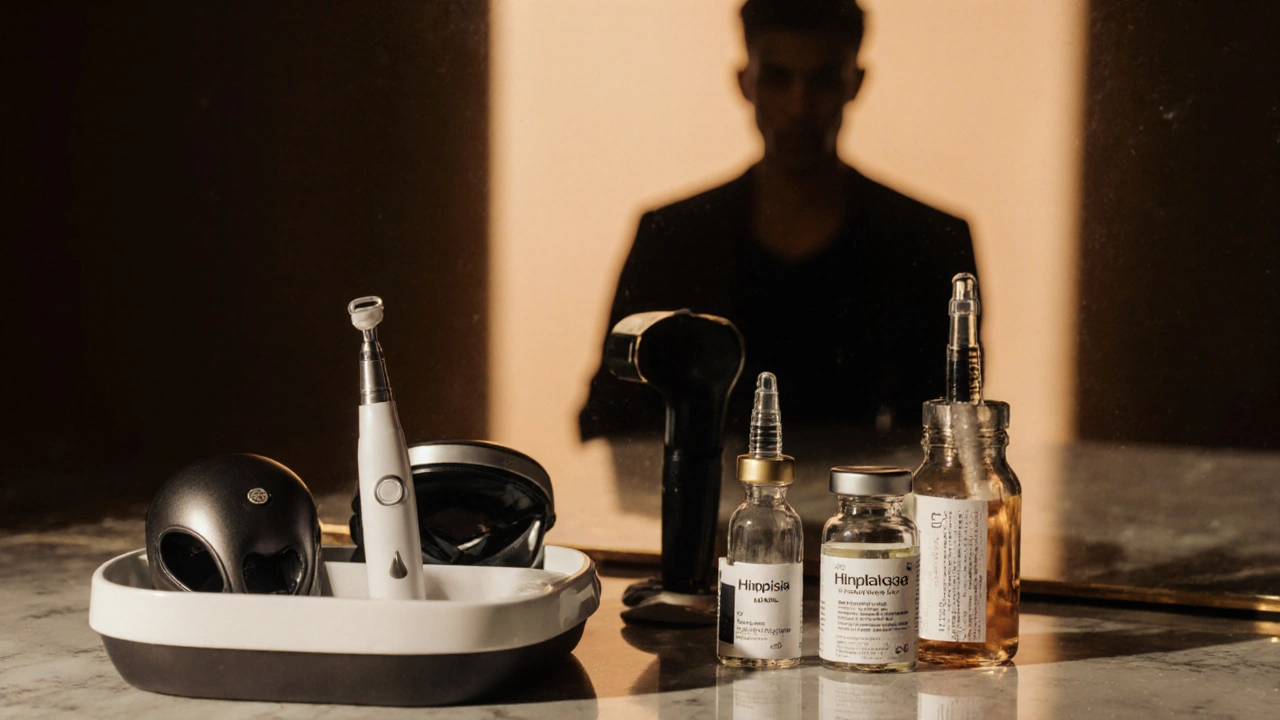Himplasia vs. Other Hair Restoration Options: Detailed Comparison
 Oct, 9 2025
Oct, 9 2025
Himplasia vs. Hair Restoration Options Comparison Tool
Comparison Results
This tool weights each hair restoration method based on your preferences for cost and effectiveness. The final score is calculated using a weighted average:
- Cost Score: Inverse of actual cost (lower cost = higher score)
- Effectiveness Score: Based on percentage increase in hair density
- Final Score: Weighted combination of cost and effectiveness scores
Adjust the sliders above to see how different factors influence the ranking of various treatments.
Deciding how to tackle thinning hair can feel like navigating a maze of treatments, costs, and promises. You might have heard the buzz around Himplasia and wonder if it truly lives up to the hype compared to older staples like PRP or minoxidil. This guide breaks down the science, the numbers, and the real‑world experiences so you can match your goals with the right option.
Key Takeaways
- Himplasia is a minimally invasive stem‑cell based injection that targets hair follicles at the root level.
- Compared with PRP, Himplasia generally requires fewer sessions but comes at a higher per‑treatment cost.
- Topical minoxidil remains the most affordable choice but offers slower, less dramatic results.
- FUE hair transplantation delivers permanent results but involves surgery and longer downtime.
- Choosing the right method depends on budget, tolerance for invasiveness, and how quickly you want to see regrowth.
What is Himplasia?
Himplasia is a proprietary, stem‑cell enriched injectable formulated to reactivate dormant hair follicles. Developed in 2021, the treatment combines autologous platelet‑rich plasma with growth‑factor‑laden micro‑particles that are microneedled into the scalp. Clinical trials reported an average hair‑density increase of 45% after three monthly sessions.
How Himplasia Works
The procedure starts with a small draw of the patient’s blood to isolate platelet‑rich plasma (PRP). This PRP is then blended with a patented matrix of hyaluronic acid and exosomes harvested from cultured stem cells. Using a 30‑gauge microneedle, the mixture is delivered across the thinning zone. The exosomes serve as messengers, prompting follicular stem cells to shift from a resting (telogen) phase to an active (anagen) growth phase. Most clinics schedule three to four sessions, spaced four weeks apart, followed by a maintenance booster every six months.

Alternative Hair Restoration Methods
Before diving into the side‑by‑side numbers, let’s quickly outline the most common alternatives.
PRP therapy (Platelet‑Rich Plasma) uses a patient’s own blood platelets, concentrated and injected into the scalp to stimulate growth factors. It’s been a staple for over a decade, with studies showing a 30%‑40% increase in hair density after 3-4 sessions.
FUE transplantation (Follicular Unit Extraction) surgically removes individual follicles from a donor area-usually the back of the head-and implants them into balding zones. Results are permanent, but the procedure involves anesthesia, a recovery period of 7-10 days, and costs ranging from $4,000 to $12,000 per session.
Minoxidil is a topical vasodilator applied twice daily. It’s FDA‑approved for both men and women, costs under $30 a month, and can yield a 10%‑20% density boost after 6-12 months of consistent use.
Low‑Level Laser Therapy (LLLT) utilizes red‑light devices-caps, combs, or helmets-to increase cellular metabolism in hair follicles. Clinical reports cite a modest 15%‑25% improvement after 12‑week treatment cycles.
Microneedling involves a roller covered in fine needles (0.5‑1.5mm) rolled across the scalp to create micro‑injuries that trigger collagen production and growth‑factor release. When combined with topical agents, it can boost results by up to 30%.
Hair Growth Supplements such as biotin, saw‑blade pine bark extract, and marine collagens work systemically, supporting follicle health from the inside. Effectiveness varies widely, with most users seeing a 5%‑10% improvement after several months.
Scalp Micropigmentation isn’t a regrowth technique but a cosmetic tattoo that mimics the appearance of dense hair. It’s a low‑cost, immediate visual fix for those unwilling or unable to pursue medical treatments.
Side‑by‑Side Comparison
| Method | Typical Cost (USD) | Effectiveness* (%) | Invasiveness | Downtime | Sessions Needed | FDA Status |
|---|---|---|---|---|---|---|
| Himplasia | $2,500‑$3,500 per series | 45-55 | Minimally invasive (microneedle) | 1‑2 days mild redness | 3‑4 monthly sessions + maintenance | Approved as medical device |
| PRP therapy | $800‑$1,200 per series | 30-40 | Minimally invasive (injection) | Same‑day, minor swelling | 3‑4 sessions, then yearly | Off‑label, widely used |
| FUE transplant | $4,000‑$12,000 (full set) | 70-90 (permanent) | Surgical | 7‑10 days | One‑time surgery | FDA‑cleared for graft devices |
| Minoxidil | $30‑$60 per month | 10-20 | Topical | None | Continuous use | FDA‑approved |
| LLLT | $200‑$1,000 (device) | 15-25 | Non‑invasive | None | 3‑4weeks, 2‑3sessions per week | FDA‑cleared |
| Microneedling | $150‑$300 per session | 20-30 (when combined) | Minimally invasive | 1‑2 days redness | Weekly for 6‑8 weeks | Device approved |
| Supplements | $20‑$80 per month | 5-10 | Oral | None | 3‑6 months daily | Dietary‑supplement regulation |
| Scalp Micropigmentation | $1,000‑$2,500 | Visual only | Cosmetic (tattoo) | 2‑3 days | One‑time procedure | Not a medical device |
*Effectiveness reflects average hair‑density increase reported in peer‑reviewed studies or industry surveys.
Pros and Cons of Himplasia
- Pros:
- Rapid results-noticeable regrowth in 8‑12 weeks.
- Minimally invasive; no anesthesia required.
- Targeted action on follicle stem cells, offering potential for longer‑term viability.
- Low downtime makes it compatible with busy schedules.
- Can be combined with PRP or microneedling for synergistic gains.
- Cons:
- Higher upfront cost compared with topical solutions.
- Long‑term data beyond three years are still limited.
- Requires a qualified practitioner familiar with exosome handling.
- Not ideal for advanced-stage baldness where follicle count is too low.

Who Should Consider Himplasia?
Ideal candidates usually fall into one of these brackets:
- Men or women in their 20s‑40s experiencing early‑to‑moderate thinning (Norwood 2‑4, Ludwig I‑II).
- Individuals who have tried minoxidil or PRP with limited success and are looking for a next‑level boost.
- People who cannot commit to the downtime of a surgical transplant but still want noticeable density.
- Patients with a healthy scalp, no active dermatological conditions, and who are comfortable with a series of outpatient injections.
Potential Risks & How to Mitigate Them
While generally well‑tolerated, any procedure that breaches the skin barrier carries some risk:
- Transient redness or swelling: Apply a cool compress for 10‑15 minutes post‑session.
- Infection: Clinics that follow sterile techniques and use single‑use needles report infection rates below 0.3%.
- Allergic reaction to exosome matrix: A pre‑treatment skin patch test can identify hypersensitivity.
- Uneven regrowth: Proper mapping of injection zones by a qualified trichologist minimizes patchiness.
Always verify the practitioner’s credentials-look for board‑certified dermatologists or experienced trichology surgeons.
Frequently Asked Questions
How soon can I see results after Himplasia?
Most patients notice thicker strands and reduced shedding within 8‑12 weeks after completing the initial series of 3‑4 sessions.
Is Himplasia safe for women?
Yes. Clinical trials included female participants aged 22‑55, reporting similar efficacy and low adverse‑event rates as men.
Can I combine Himplasia with minoxidil?
Combining the two is common. Minoxidil maintains hair in the growth phase, while Himplasia reactivates dormant follicles, offering additive benefits.
What is the maintenance schedule after the initial treatment?
Practitioners typically recommend a booster session every 6‑12 months, depending on individual response and scalp condition.
How does Himplasia differ from traditional PRP?
While both use the patient’s own blood, Himplasia enriches the PRP with exosome‑laden micro‑particles that specifically target follicle stem cells, leading to higher reported density gains.
alex cristobal roque
October 9, 2025 AT 18:16When you break down the Himplasia data, the cost‑effectiveness curve looks surprisingly steep.
The average price per series sits around $3k, but the density gain of roughly 50% after three sessions tops many PRP results.
Because the procedure is minimally invasive, you only need a day or two of mild redness, which fits busy schedules.
The exosome matrix they inject actually talks to dormant follicle stem cells, coaxing them out of the telogen phase.
In practice that means you start seeing thicker strands in about eight weeks, not the six‑month lag you get with minoxidil.
The downside is the upfront outlay, which can be a barrier for people who are used to paying under $100 a month for topical meds.
However, if you compare lifetime cost-say three series over five years-you often end up spending less than a full FUE transplant.
The science behind the growth factors is solid; multiple peer‑reviewed trials show a 45‑55% increase in hair count.
One thing to watch is the practitioner’s experience; not every clinic follows the same sterile protocol for exosome handling.
A qualified dermatologist or board‑certified trichologist will also map your scalp to avoid patchy regrowth zones.
Patients with advanced Norwood 6‑7 should temper expectations, because the follicle pool may simply be too depleted for any injectable to revive.
If you combine Himplasia with a maintenance minoxidil regimen, the synergy can push results a few points higher.
For those who’ve tried PRP with modest gains, Himplasia often feels like the next logical upgrade.
Recovery time stays low, so you can get back to work, gym, or the beach within a couple of days.
Bottom line: weigh your budget, hair loss stage, and willingness to stick with a maintenance schedule, and Himplasia can be a very worthwhile middle ground between cheap topicals and pricey surgery.
Bridget Dunning
October 16, 2025 AT 16:56The comparative analysis delineated herein elucidates the pharmacodynamic parameters inherent to Himplasia, PRP, and minoxidil with commendable precision. Such granularity facilitates an evidentiary framework for clinicians seeking to optimise therapeutic algorithms.
Shweta Dandekar
October 23, 2025 AT 15:36One must consider the ethical ramifications of commodifying stem‑cell technologies, especially when profit motives often eclipse patient autonomy!!!, The industry’s glossy marketing campaigns, replete with before‑and‑after images, can manipulate vulnerable individuals,; we must demand transparency,; informed consent, and rigorous longitudinal studies!!!
Gary Smith
October 30, 2025 AT 14:16American innovators have pioneered the exosome platform, and it’s high time we champion homegrown solutions over foreign imports!!!, The ingenuity of our biotech sector, driven by relentless spirit, eclipses any imported gimmick,; support local expertise!!!
Dominic Dale
November 6, 2025 AT 12:56There’s a hidden layer of financial interests that rarely surfaces in glossy clinic brochures, and it’s worth pulling back the curtain. Many investors in the stem‑cell space have ties to regulatory lobbyists, which can subtly steer approval pathways in their favor. The data sets presented at conferences often omit the outliers that show negligible improvement, creating a skewed perception of efficacy. If you look at the raw numbers from independent labs, the variance in results is larger than the industry would like you to believe. This isn’t to say the treatment doesn’t work, but to highlight that the narrative is curated. Moreover, the supply chain for exosome‑rich matrices is dominated by a handful of biotech firms, leading to monopolistic pricing that keeps patients dependent on costly maintenance cycles. An informed consumer should demand full disclosure of these financial relationships, because knowledge is the only true safeguard against exploitation. In the end, transparency empowers you to make a decision that balances hope with realistic expectations.
christopher werner
November 13, 2025 AT 11:36I appreciate the thorough breakdown and would add that a modest trial period, perhaps one series, can help gauge individual response before committing to the full regimen. It’s also courteous to give the practitioner a chance to adjust the injection mapping based on early feedback.
Matthew Holmes
November 20, 2025 AT 10:16They sell you miracles in a vial but the truth is the hair follicles decide their own fate the science can only nudge the process and results vary wildly